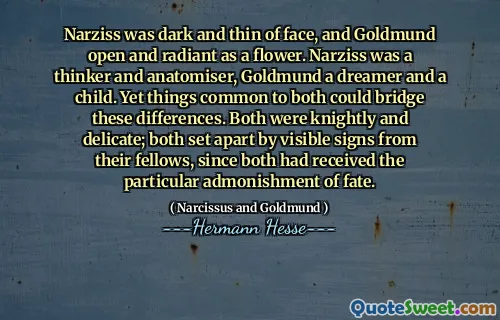"Narcissus and Goldmund," a novel by Hermann Hesse, explores the divergent paths of two characters, Narcissus and Goldmund, in medieval Europe. Narcissus is an intellectual monk who values reason and stability, while Goldmund is a free-spirited artist who seeks passion and the beauty of life. Their contrasting philosophies represent the conflict between the intellectual and the instinctual aspects of human existence.
As the story unfolds, Goldmund embarks on a journey to discover his purpose and identity outside the confines of the monastery where he grew up. He experiences the richness of life through relationships, nature, and art, all while grappling with the inevitability of change and mortality. This pursuit of experience leads him to understand the deeper truths of existence.
Narcissus, on the other hand, remains anchored in his scholarly pursuits, believing in the value of knowledge and reason. Yet, his friendship with Goldmund profoundly impacts him, highlighting the balance between intellect and emotion. Ultimately, the novel presents a meditation on the importance of embracing both the spiritual and sensual aspects of life, inviting readers to reflect on their own paths between these dualities.
More »
Today Birthdays
1943 -
Sam Shepard
1957 -
Daniel Gilbert
1926 -
John Berger
1967 -
Jen Lancaster
1965 -
Atul Gawande
1855 -
Eugene V. Debs
1980 -
Clay Clark
1893 -
Raymond Loewy
1983 -
Alexa Chung
1857 -
Ida Tarbell
1988 -
Virat Kohli
1955 -
Kris Jenner
1920 -
Douglass North
1939 -
Lobsang Tenzin
1961 -
Alan G. Poindexter
1976 -
Ben Quayle
1892 -
John B. S. Haldane
1971 -
Jonny Greenwood
1940 -
Ted Kulongoski
1918 -
George A. Sheehan
1931 -
Ike Turner
1948 -
Peter Hammill
1967 -
Judy Reyes
1949 -
Rick Smolan
1960 -
Tilda Swinton
1965 -
Famke Janssen
1955 -
Jay S. Walker




